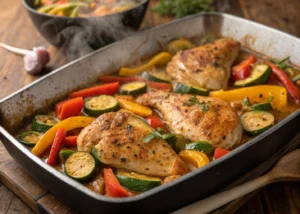
For those who appreciate the rich, earthy flavors of traditional comfort food, Liver & Onions is a timeless classic. This recipe demystifies cooking liver, showing you how to achieve perfectly tender slices, beautifully caramelized onions, and a savory meal that’s both deeply satisfying and surprisingly easy to prepare. Say goodbye to bitterness and hello to a delicious, nostalgic dish!
Why I Love This Recipe
Liver and Onions might be a divisive dish for some, but for those who love it, it’s pure culinary comfort. What I truly adore about this recipe is how it guarantees a tender, flavorful liver experience, eliminating any bitterness. The simple act of soaking the liver in milk is a game-changer, ensuring a mild, pleasant taste. Then, pairing it with sweet, caramelized Vidalia onions cooked in butter creates an irresistible savory depth that perfectly complements the rich liver. The quick pan-fry method ensures a beautiful brown crust while keeping the inside tender. It’s a humble dish elevated, a true testament to how simple ingredients, handled correctly, can create something truly delicious and deeply satisfying.
Ingredients
Here’s what you’ll need to create this delicious Liver & Onions:
- 2 pounds sliced beef liver (about 1/4 to 1/2 inch thick)
- 1 ½ cups milk, or as needed (any percentage milk)
- ¼ cup butter, divided (unsalted recommended)
- 2 large Vidalia onions, sliced
- 2 cups all-purpose flour, or as needed
- Salt and black pepper to taste
Swaps and Notes
- Beef Liver: Look for fresh, thinly sliced beef liver. While this recipe focuses on beef, calf’s liver is even more tender if available.
- Milk: Any type of dairy milk (whole, 2%, skim) works for soaking the liver. This step is crucial for removing bitterness and tenderizing the meat.
- Butter: Unsalted butter is preferred to control the salt content. It adds incredible flavor to both the onions and the liver.
- Vidalia Onions: Vidalia onions are excellent for their natural sweetness and mild flavor, which caramelizes beautifully. Yellow or sweet onions can be substituted. Slice them relatively thick so they don’t disintegrate.
- All-Purpose Flour: This creates a light, crispy coating on the liver. You may need slightly more or less than 2 cups depending on the size and moisture of your liver slices.
- Seasoning: Don’t be shy with salt and pepper on the flour. This is where a lot of the savory flavor for the coating comes from.
Directions
Let’s get this delicious Liver & Onions cooking!
- Prepare Liver (Soak): Gently rinse the sliced beef liver under cold water and pat each slice thoroughly dry with paper towels. Place the liver slices in a shallow dish (such as a pie plate or a shallow bowl). Pour enough milk over the liver slices to completely cover them. Let the liver stand in the milk for at least 15 minutes while you prepare the onions. If you have more time, you can soak it for up to 30-60 minutes in the refrigerator. Soaking the liver in milk is a traditional and effective way to remove any bitterness and tenderize it.
- Sauté Onions: While the liver is soaking, melt 2 tablespoons of the butter in a large skillet (cast iron or heavy-bottomed stainless steel works well) over medium heat. Add the 2 large sliced Vidalia onions to the skillet. Cook and stir the onions in the butter until they become tender, soft, and slightly translucent, which should take about 3 to 5 minutes. Transfer the cooked onions into a bowl and set the skillet aside; do not clean it as you’ll use it for the liver.
- Prepare Liver Coating: Place the 2 cups all-purpose flour (or as needed) on a plate or in a wide shallow dish. Season the flour generously with salt and black pepper to taste, mixing it well.
- Coat Liver: Remove the liver slices from the milk, letting any excess milk drip off. Do not rinse the liver after soaking. Dredge each liver slice thoroughly in the seasoned flour mixture, ensuring both sides are well coated. Gently shake off any excess flour.
- Fry Liver: Melt the remaining 2 tablespoons of butter in the same skillet (where you cooked the onions) over medium-high heat. Once the butter is melted and slightly foamy, carefully place the coated liver slices into the hot skillet. Do not overcrowd the pan; cook in batches if necessary to ensure a good sear. Fry the liver slices until they are lightly browned and caramelized, about 4 minutes on each side. The liver should still be slightly pink in the center for optimal tenderness.
- Combine & Finish: Return the sautéed onions to the skillet with the fried liver slices. Reduce the heat to medium. Continue to cook for another 2-3 minutes, stirring gently, until the onions are heated through and the liver is done to suit your taste (cook for a minute or two longer if you prefer it more well-done).
Tips for Success
- Soak the Liver: This step is crucial for mellowing the flavor and tenderizing the liver. Don’t skip it!
- Don’t Overcook Liver: Liver cooks very quickly and can become tough if overcooked. Aim for it to be lightly browned on the outside and just a little pink in the center.
- Hot Pan for Searing: Ensure your skillet is hot enough when adding the liver to get a good sear and crispy crust.
- Slice Onions Evenly: Consistent onion slices will cook evenly and caramelize beautifully.
- Butter for Flavor: Butter adds incredible richness to both the onions and the liver.
- Season the Flour: Seasoning the flour ensures the coating itself is flavorful, contributing to the overall deliciousness.
Serving Suggestions and Pairings
Liver & Onions is a hearty, classic comfort food that pairs wonderfully with simple, satisfying sides:
- Mashed Potatoes: The creamy richness of mashed potatoes is the perfect complement to the savory liver and onions.
- Southern Green Beans: A classic side that adds freshness and a touch of tang. (Perhaps our Country Green Beans with Smoked Turkey!)
- Grits: For a more Southern-inspired breakfast or dinner pairing.
- Cornbread: A warm slice of cornbread is excellent for soaking up any pan juices.
- For other incredibly comforting and hearty main dishes, consider our This Cajun Chicken Sausage Gumbo Is My Favorite Bowl Of Southern Comfort or our These Easy Turkey Wings Are My Favorite Comfort Food For Lazy Sundays.
Storage and Leftover Tips
Liver & Onions is truly best enjoyed fresh for optimal tenderness and flavor.
- Refrigeration: Store any cooled leftovers in an airtight container in the refrigerator for up to 1-2 days. The liver may become slightly firmer upon cooling.
- Reheating: Reheat gently on the stovetop over low heat, adding a tiny splash of broth or water if needed, until warmed through. Avoid high heat and prolonged reheating, which can toughen the liver. Microwaving is generally not recommended for optimal texture.
- Freezing: Freezing cooked liver is not recommended as it significantly changes the texture, making it rubbery and less palatable upon thawing.
More Recipes You Will Love
If you loved the savory, comforting, and classic nature of this dish, you’ll definitely want to explore some of our other fantastic, fuss-free recipes that bring warmth and satisfaction to your table:
- For another easy savory appetizer with big flavor, check out our This Baked Kosher Salami Is My Favorite Easy Appetizer With Big Flavor.
- If you’re a fan of quick and flavorful skillet meals, our This Tomato Skillet With Okra And Sausage Is My Favorite Quick Dinner Packed With Southern Flavor is a fantastic option.
- And for a fun, interactive way to feed a crowd, our This Walking Taco Bar Is My Favorite No-Fuss Way To Feed A Crowd is always a hit!
Final Thoughts
This Liver & Onions recipe is a brilliant guide to preparing a truly classic and comforting meal. With a few simple techniques, you can transform humble ingredients into a deeply flavorful and satisfying dish that might just surprise you!
Give this recipe a try and rediscover the deliciousness of liver and onions! What’s your favorite classic “old-fashioned” comfort food? Share your ideas and feedback in the comments below! And for more amazing, easy-to-follow recipes that bring joy to your kitchen, be sure to visit Chefmaniac.com. Happy cooking!




Leave a Reply to Betty C Rhyne Cancel reply